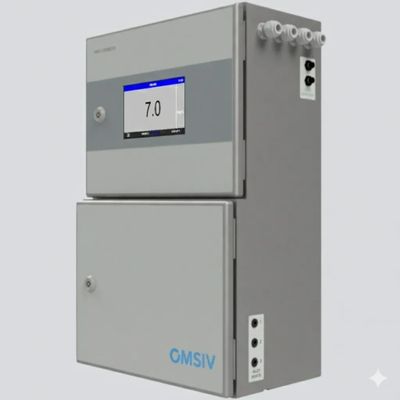Chlorine Cl2

Applications
- Drinking water
- Municipal wastewater
- Industrial wastewater discharge limit monitoring or process optimization
- Food and beverage
- Power and semiconductors
- Reverse osmosis (RO) process
Description
The JAL-Z colorimeter is a compact analytical instrumentation for online analysis and process monitoring. The colorimeter is based on a color-developing chemical reaction carried out inside the analyzer's glass cell. The sample, coming from an external reservoir or process stream is autonomously grabbed by the instrument and mixed with the appropriate reagents to make the reaction happen. The analyzer uses an LED light source and a photodiode to photometrically measure the developed color intensity (absorbance). The absorbance is proportional to the concentration of the target chemical species (analite).
Features
- Low reagents consumption and analytical reliability thanks to our custom designed miniature peristaltic pumps
- Dual compartment design to guarantee a complete separation between the electronics and the hydraulic section
- Color touchscreen to show the last measured value clearly, and to set all the options and settings via an user friendly interface
- Datalogger function with data history in graphical form and USB download
- Automatic calibration, validation and cleaning to reduce down time and operator intervention, their frequency can be freely set by the user
- Fully integrable in industrial automation via the analog outputs (2 x 4-20 mA channels), digital output (2 relays + ModbusRTU) and digital input (voltage free contact)
Chlorine is measured using the DPD colorimetric method (US EPA 4500-CI G and ISO 7393-2 accepted method). The determination ranges of the analyzer vary from trace μg/L to 200 mg/L Cl2 using the (optional) internal dilution module.
METHOD
Chlorine, free
Chlorine-containing samples are reacted with N,N-diethyl-p-phenylenediamine sulfate in the presence of a suitable buffer. The indicator and buffer are added and react with chlorine to produce a pink color. This compound is measured at 525 nanometers.
Features
Measured parameter: Cl2
Range :
(Ø 26 mm) 2000 ppb
(Ø 16 mm) 5000 ppb
(with dilution) 200 ppm
Reproducibility*
(Ø 26 mm) ± 0.01 ppm / ± 3% (0-1 ppm),
± 0.02 ppb / ± 3% (1-2ppm)
(Ø 16 mm) ± 0.05 ppm / ± 3%
* if two values take whichever is greater
Limit of detection : 0.01 ppm
Wavelength : 525 nm
Demineralized water : Not required
Interferences : Peroxides, bromine, iodine, ozone.
Reference : ISO 7393-2:2018
Number of reagents: 2
Min. analysis time : 6 minutes
Default analysis time : 15 minutes
Reagent consumption**
(Ø 26 mm) 2 L
(Ø 16 mm) 1 L
** per month, at the default analysis frequency.
Chlorine, Total
Chlorine-containing samples are reacted with N, N-diethyl-p-phenylenediamine sulfate in the presence of a suitable buffer. The indicator and buffer are added and react with chlorine to produce a pink color. This compound is measured at 525 nanometers. In total chlorine and monochloramine measurements, potassium iodide is added.
Features
Measured parameter: Cl2
Range :
(Ø 26 mm) 0.01 - 1 ppm
(Ø 16 mm) 0.02 - 2 ppm
(with dilution) 0.8 - 200 ppm
Reproducibility*
(Ø 26 mm) ± 0.01 ppm / ± 3% (0-1 ppm),
± 0.02 ppb / ± 3% (1-2ppm)
(Ø 16 mm) ± 0.05 ppm / ± 3%
* if two values take whichever is greater
Limit of detection : 0.01 ppm
Wavelength : 525 nm
Demineralized water : Not required
Interferences : Peroxides, bromine, iodine, ozone.
Reference : ISO 7393-2:2018
Number of reagents: 2
Min. analysis time : 6 minutes
Default analysis time : 15 minutes
Reagent consumption**
(Ø 26 mm) 2 L
(Ø 16 mm) 1 L
** per month, at the default analysis frequency.
Chlorine, Free+Total
Chlorine-containing samples are reacted with N, N-diethyl-p-phenylenediamine sulfate in the presence of a suitable buffer. The indicator and buffer are added and react with chlorine to produce a pink color. This compound is measured at 525 nanometers. In total chlorine measurements, potassium iodide is added.
Features
Measured parameter: Cl2
Range :
(Ø 26 mm) 0.01 - 1 ppm
(Ø 16 mm) 0.02 - 2 ppm
(with dilution) 0.8 - 200 ppm
Reproducibility*
(Ø 26 mm) ± 0.01 ppm / ± 3% (0-1 ppm),
± 0.02 ppb / ± 3% (1-2ppm)
(Ø 16 mm) ± 0.05 ppm / ± 3%
* if two values take whichever is greater
Limit of detection : 0.01 ppm
Wavelength : 525 nm
Demineralized water : Not required
Interferences : Peroxides, bromine, iodine, ozone.
Reference : ISO 7393-2:2018
Number of reagents: 3
Min. analysis time : 6 minutes
Default analysis time : 15 minutes
Reagent consumption**
(Ø 26 mm) 2 L
(Ø 16 mm) 1 L
** per month, at the default analysis frequency.
Downloads
JAL-Z_Chlorine-Colorimeter-Datasheet (pdf)
DownloadThis website uses cookies.
We use cookies to analyze website traffic and optimize your website experience. By accepting our use of cookies, your data will be aggregated with all other user data.
